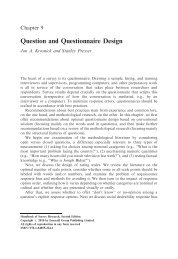Four Strategies for the Age of Smart Services - Courses
Four Strategies for the Age of Smart Services - Courses
Four Strategies for the Age of Smart Services - Courses
Create successful ePaper yourself
Turn your PDF publications into a flip-book with our unique Google optimized e-Paper software.
8 <strong>of</strong> 8<br />
• The Impact <strong>of</strong> Networking.<br />
If technicians know in advance that <strong>the</strong> HVAC system in a commercial <strong>of</strong>fice building may break down (because <strong>the</strong> connectivity <strong>the</strong>y’ve built into<br />
<strong>the</strong> system allows <strong>the</strong> equipment to be continually monitored), <strong>the</strong>y can diagnose and repair <strong>the</strong> problem be<strong>for</strong>e tenants notice any issues. They can<br />
eliminate <strong>the</strong> downtime and <strong>the</strong> expense <strong>of</strong> evacuating <strong>the</strong> building.<br />
• The Cost and Ease <strong>of</strong> Connectivity.<br />
Most companies can com<strong>for</strong>tably justify buildingwide networking or device enablement because <strong>the</strong>y can amortize <strong>the</strong> expense across multiple<br />
departments and products. By contrast, <strong>the</strong> initial costs and complications <strong>of</strong> creating a home network are prohibitive <strong>for</strong> most households.<br />
• The Device Turnover Rate.<br />
If you add connectivity to a device with a life span <strong>of</strong> more than 15 years, you will probably create a technology obsolescence problem—even if <strong>the</strong><br />
device is designed so it can be updated remotely via s<strong>of</strong>tware downloads and so on. Meanwhile, a device with a very short life span might be<br />
networked only <strong>for</strong> its content or commerce opportunities ra<strong>the</strong>r than <strong>for</strong> its per<strong>for</strong>mance or maintenance considerations, potentially making <strong>the</strong> ROI<br />
harder to achieve.<br />
• The Service Needs.<br />
If a vending machine could notify its owner when it needed to be restocked or repaired, <strong>the</strong> company could use employees much more efficiently<br />
and save a significant amount <strong>of</strong> money by eliminating unnecessary site visits.<br />
• The Importance <strong>of</strong> In<strong>for</strong>mation.<br />
Medical devices that need to transmit vital health in<strong>for</strong>mation quickly to a variety <strong>of</strong> people and locations are excellent candidates <strong>for</strong> networking.The<br />
ability to simultaneously in<strong>for</strong>m technicians, specialists, primary care physicians, and <strong>the</strong> patient is extremely valuable.<br />
• The Location <strong>of</strong> <strong>the</strong> Device.<br />
Certain devices and systems are harder to maintain than o<strong>the</strong>rs simply because <strong>of</strong> <strong>the</strong>ir location. If a motor in an <strong>of</strong>fshore oil rig could remotely<br />
in<strong>for</strong>m <strong>the</strong> owners <strong>of</strong> its health and per<strong>for</strong>mance, complicated and unnecessary service visits would be a thing <strong>of</strong> <strong>the</strong> past.<br />
Out <strong>of</strong> <strong>the</strong> Basement<br />
If you take only one message away from Eaton Electrical’s Home Heartbeat initiative, it should be that successful product-centric businesses are<br />
rapidly transitioning to smart services. The story is all <strong>the</strong> more interesting because it goes beyond <strong>the</strong> business-to-business realm, bringing <strong>the</strong><br />
benefits <strong>of</strong> machine-to-machine communication to home owners.<br />
Cleveland-based Eaton started out in 1911 making axles and o<strong>the</strong>r truck parts and later diversified into o<strong>the</strong>r engineered components, including<br />
residential circuit breakers. As <strong>the</strong> end <strong>of</strong> its first century in business approached, it found itself in very mature businesses fighting with established<br />
competitors over every point <strong>of</strong> market share. That’s when a few visionary managers within <strong>the</strong> electrical products division started to think about<br />
device connectivity and <strong>the</strong> broader solutions it could <strong>of</strong>fer consumers.<br />
The system <strong>the</strong>y envisioned, recently launched as Home Heartbeat, monitors <strong>the</strong> status <strong>of</strong> a home and alerts <strong>the</strong> home owner when something is<br />
amiss. To do this, it uses water sensors, open/closed sensors, and power sensors, which communicate to a base station over a wireless network. That<br />
base station communicates with a key fob device carried by <strong>the</strong> home owner. The system can also be instructed to send an e-mail or text message to<br />
a cell phone if <strong>the</strong>re is a change in <strong>the</strong> state <strong>of</strong> a sensor.<br />
Pause <strong>for</strong> a moment to consider how useful this would be. You’re sitting on <strong>the</strong> train to work, and it occurs to you that a space heater might have been<br />
left on. You can check your key fob to be reassured instead <strong>of</strong> having to turn back. (The key fob device works only within a certain range <strong>of</strong> distance<br />
but does capture data about <strong>the</strong> status <strong>of</strong> your home as you left it.) Home Heartbeat features a water shut-<strong>of</strong>f valve that can be automatically activated<br />
by sensors. So if you’re on vacation, and you hear about a cold snap, power outages, and burst pipes back home, you can check your e-mail; in <strong>the</strong><br />
meantime, you can be confident that if <strong>the</strong> water needed to be shut <strong>of</strong>f, it was.<br />
Home Heartbeat is a good example <strong>of</strong> smart service innovation: Eaton built awareness and connectivity into <strong>the</strong> devices it was already selling and, in<br />
this way, was able to position itself not just as a product vendor but also as a service provider. No longer consigned to an obscure corner <strong>of</strong> <strong>the</strong><br />
basement, <strong>the</strong> Eaton brand now stands <strong>for</strong> total home awareness. And <strong>the</strong> company is now in <strong>the</strong> role <strong>of</strong> aggregator, courting an entirely new range <strong>of</strong><br />
partners, from wireless carriers to insurance companies.
















